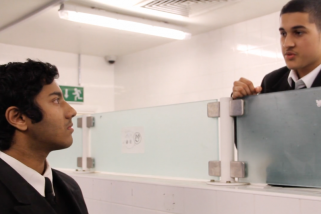The following advice comes from Chris White from the Royal Shakespeare company who worked with the students on Friday afternoon. He concentrated on a single soliloquy from Act 3, Scene 1 (Attached at the bottom)
- Feminine ending of line 3 a good example of form and content working together: the iambic line is not sufficient to contain the surge of emotion, hence the ‘o’erflow’
- Monosyllabic lines: line 4 is a good example. A technique Shakespeare uses often to encourage the actor to give space and time for the words. It is a technique that serves as an emotional clue to the actor
- Alliteration through the first 8 lines, of ‘w’: an encouragement for the actor to make a thread through these sounds and to draw particular attention to ‘woes’ – the emotional centre of the speech; and ‘welkin’ – Lavinia, the subject of the speech and source of woe.
- Personification: good example in line 5. As with the use of metaphor in line 7 and beyond, it is a clue to the actor that there is a need to reach beyond the everyday to encompass the scale of feeling
- Caesura: really strong example in line 7; when in the middle of the line there is a change of thought and sense that is indicated by a semi-colon (as here) or a full stop. In this case, the technique is used to steer the actor towards a big shift. Here it is ‘I’ to ‘her’ and the strong suggestion is that her actual physical presence shocks him anew. So, again, the literary technique is deployed to steer the actor towards a sudden shift in focus and emotion
- Repetition in line 9 and 10 suggests a build and growth towards climax, which is further shown through…
- Enjambment: where the sense of line 10 overflows into line 11. Previously, the sense pretty much fits within each verse line. The fact that it over spills here is another clue to the actor that when the form ceases to be regular, the emotional current is at its strongest and the speaker, Titus, is struggling to express the full weight of what he is feeling and undergoing.
- Sound carrying meaning: there is probably a better technical term for this but we observed that near the end of the speech the word ‘vomit’ sticks out. Again, the reason is technical: Shakespeare has avoided using the ‘v’ sound until now so that is has maximum impact when it does. In an essay I would suggest referring to this as the ‘sonic range’ used by Shakespeare (?). Just after the word ‘vomit’, we also observed that the first full stop occurs. The use of this new form of punctuation suggests a pause for the actor and the suggestion that all that has gone before it has been in constant motion, a flurry, like vomiting, a quality which was detectable when you read it aloud.
In summary, the use of literary techniques are plentiful and are there to help the actor bring the words alive.
TITUS ANDRONICUS
If there were reason for these miseries,
Then into limits could I bind my woes:
When heaven doth weep, doth not the earth o’erflow?
If the winds rage, doth not the sea wax mad,
Threatening the welkin with his big-swoln face?
And wilt thou have a reason for this coil?
I am the sea; hark, how her sighs do blow!
She is the weeping welkin, I the earth:
Then must my sea be moved with her sighs;
Then must my earth with her continual tears
Become a deluge, overflow’d and drown’d;
For why my bowels cannot hide her woes,
But like a drunkard must I vomit them.
Then give me leave, for losers will have leave
To ease their stomachs with their bitter tongues.
Enter a Messenger, with two heads and a hand


Trackbacks/Pingbacks